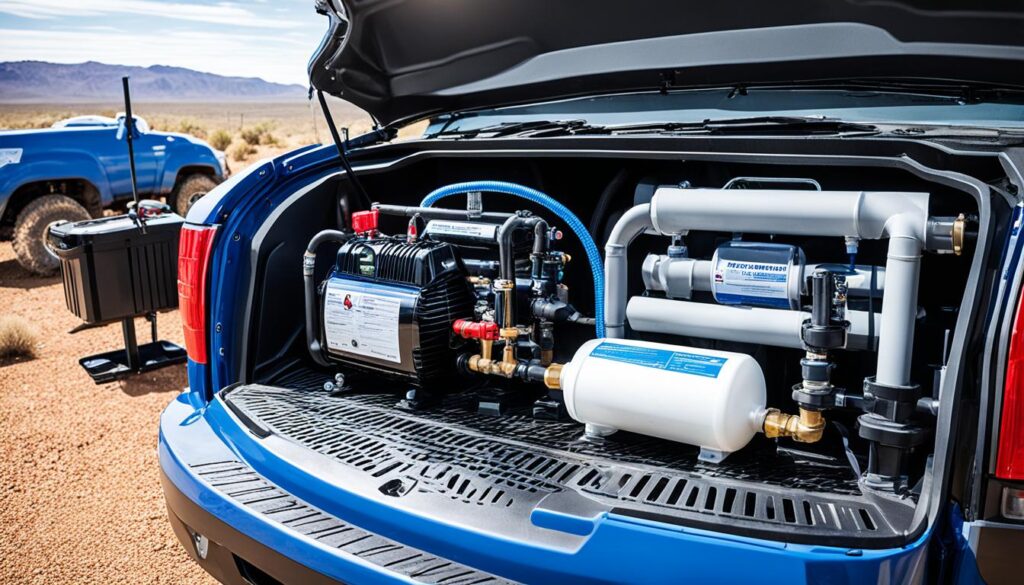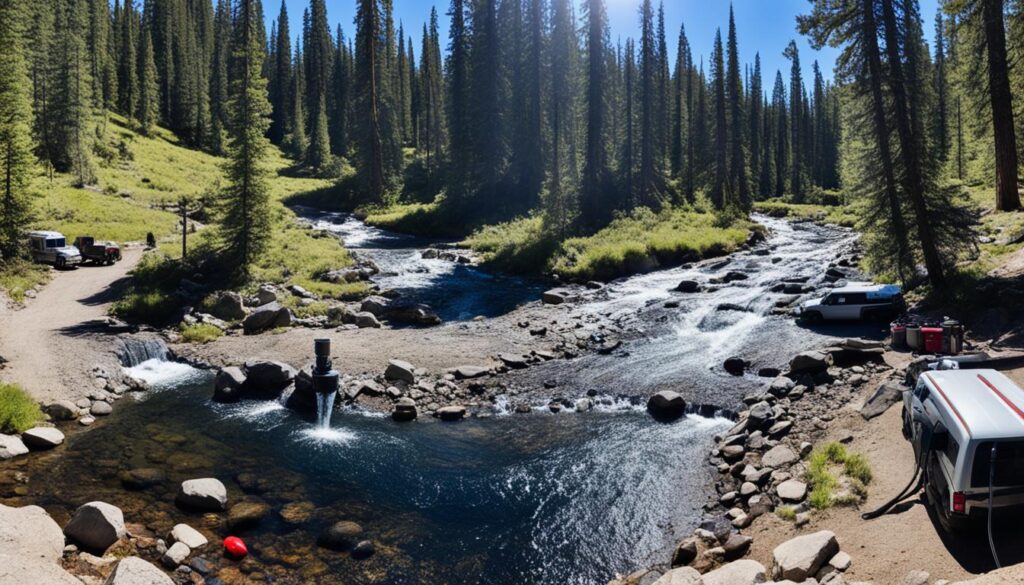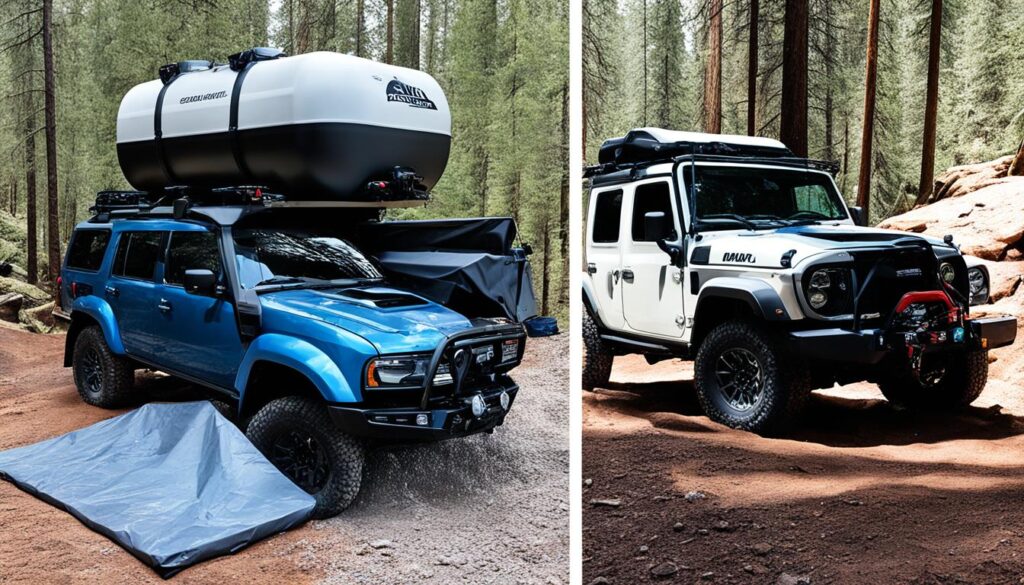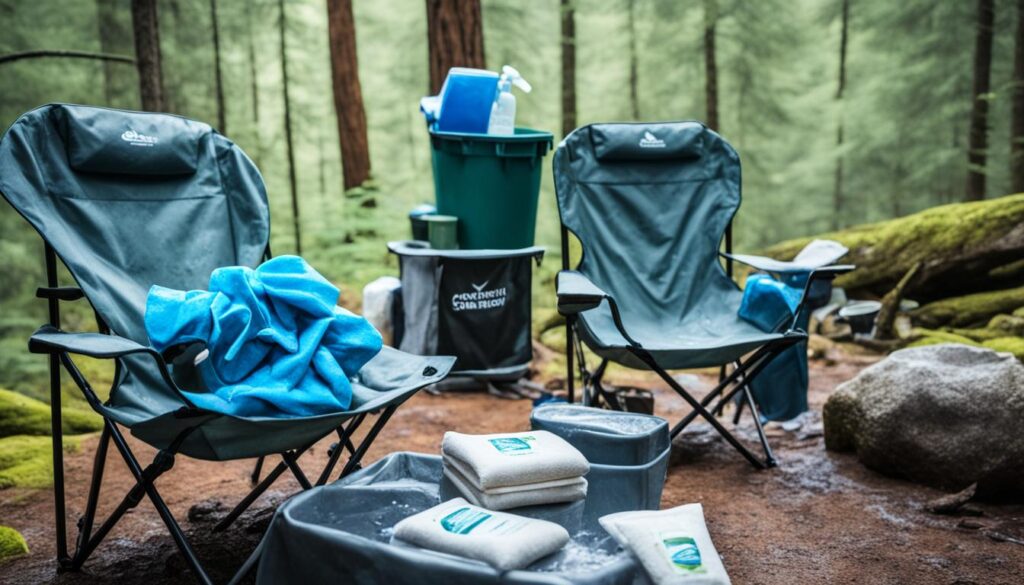When it comes to embarking on your overlanding adventures, one essential consideration often overlooked is the choice of the right water pump. A reliable water pump is crucial for ensuring a constant supply of clean drinking water throughout your journey. But how do you choose the right water pump size for your overlanding setup?
Many overlanders may be tempted to opt for the biggest and most powerful water pump available, believing that it will provide the best performance. However, this common belief may not always hold true. The right water pump size depends on various factors, including your specific water usage needs and the capacity of your water tank.
In this article, we will guide you through the essential considerations for choosing the right water pump size for overlanding. We will explore the different options available and provide expert insights to help you make an informed decision. So, whether you’re planning a weekend getaway or a long-term expedition, read on to discover the key factors that will ensure a reliable and efficient water system for your overlanding adventures.
When setting up your overlanding rig, one of the primary decisions you’ll need to make is where to mount the water tank. You have two main options: inside the cabin or underneath the frame rails. Each option comes with its own considerations, so it’s essential to weigh the pros and cons before making a decision.
Inside the Cabin
Moving the water tank inside the cabin offers several advantages. Firstly, it provides easy access to the tank, allowing for quick refills and maintenance. Secondly, placing the tank inside ensures it remains protected from external elements such as dust, debris, and extreme temperatures. This can help prolong the lifespan of the tank and maintain the quality of the stored water. Additionally, by mounting the tank inside, you can make use of the available space efficiently, especially if you have limited storage options elsewhere in your vehicle.
Underneath the Frame Rails
Mounting the water tank underneath the frame rails has its own set of benefits. By placing the tank in this location, you can optimize weight distribution, which is especially crucial for maintaining vehicle stability during off-road adventures. The tank’s position underneath also minimizes any potential loss of interior space, allowing you to use the cabin for other essential equipment or supplies. Furthermore, mounting the tank underneath can offer additional protection against damage from external elements, such as rocks or branches, as well as potential accidents on rough terrain.
Ultimately, the decision between mounting the water tank inside or underneath the rig depends on your specific needs and preferences. Consider factors such as available space, weight distribution, vulnerability to damage, and convenience of access when making your choice. Ensure that the chosen location provides easy access for refilling and maintenance while also protecting the tank from potential damage during overlanding adventures.
When selecting the mounting location for your water tank, it’s crucial to consider your overall vehicle setup and the specific demands of your overlanding trips. By carefully analyzing the advantages and disadvantages of each option, you can make an informed decision that optimizes functionality, convenience, and safety throughout your journeys.
Benefits of Mounting Inside:
- Easier access for refills and maintenance
- Protection from external elements
- Efficient use of available space
Benefits of Mounting Underneath:
- Optimized weight distribution for vehicle stability
- Preservation of interior space
- Enhanced protection against external damage
Choosing the Right Water Tank
The water tank is a crucial component of your overlanding water system. It plays a vital role in storing and providing a clean water supply for your journey. When selecting a water tank for your overlanding setup, there are several considerations to keep in mind.
Custom-Made or Generic?
One decision to make is whether to opt for a custom-made water tank or choose a generic RV or boat drinking water tank. A custom-made tank can be tailored to fit your specific space requirements, maximizing utilization in your vehicle. On the other hand, a generic tank may offer a more affordable and readily available option.
Material: Plastic vs Stainless Steel
The choice of material for your water tank is another important consideration. Plastic and stainless steel are two common options available. Plastic tanks are lightweight, resistant to corrosion and impact, and typically more affordable. On the other hand, stainless steel tanks are durable, have better insulation properties, and are resistant to UV rays. Consider factors such as weight, durability, and budget when making your decision.
It’s important to choose a water tank that is suited to your specific needs and preferences. Whether you prioritize space optimization, cost-effectiveness, or durability, make sure to select the material that best meets your requirements.
Additionally, keep in mind that plastic tanks may be more prone to scratching, which can affect their internal cleanliness. Stainless steel tanks, although durable, may be heavier and more expensive. Weigh the pros and cons of each material to make an informed decision.
Capacity and Size
Consider the capacity and size of the water tank based on your overlanding needs. A larger tank allows for more extended periods between refills but may add weight to your vehicle. Assess your water consumption requirements, the length of your trips, and the availability of water sources to determine the appropriate size for your tank.
Maintenance and Accessibility
Lastly, consider the maintenance requirements and accessibility of the water tank. Ensure that the tank is easy to clean and sanitize to prevent the growth of bacteria and other contaminants. Look for features such as removable caps or access panels that allow for easy inspection and maintenance.
Choosing the right water tank is essential for a successful overlanding experience. Carefully evaluate your needs, prioritize factors such as customizability, material, capacity, and maintenance, and select a tank that aligns with your requirements.
Filtration and Treatment Options
When embarking on overlanding adventures, it’s crucial to consider water filtration and treatment options to ensure the safety and purity of your drinking water. While tap water in North America is generally safe, filtering water from streams or questionable sources is essential. Luckily, there are various filtration and treatment systems available in the market to meet your unique needs.
1. UV Lamps
UV lamps are a popular choice for overlanders looking to eliminate harmful bacteria and viruses from their water supply. These lamps use ultraviolet light to destroy microorganisms, providing an effective and chemical-free method of water purification. UV lamps are compact and easy to use, making them ideal for on-the-go adventurers.
2. 0.5-Micron Filters
0.5-micron filters are another effective option for overlanding water filtration. These filters are designed to remove sediment, bacteria, and protozoa from water, ensuring a clean and safe drinking supply. Additionally, they can improve the taste and odor of water, enhancing your overlanding experience.
3. Combination Systems
For comprehensive water filtration and treatment, you may opt for a combination system. These systems often include multiple filtration stages, such as activated carbon, sediment filters, and UV lamps. By combining different methods, you can achieve a higher level of purification, removing a wide range of contaminants from your water.
“When it comes to choosing the right filtration and treatment system for your overlanding adventures, consider the source of your water and the specific contaminants you may encounter. Investing in a reliable filtration system will provide you with peace of mind and a safe water supply throughout your journey.”
4. Portable vs Built-in Systems
When selecting a filtration and treatment system, you’ll also need to weigh the benefits of portable systems versus built-in systems. Portable systems offer flexibility, allowing you to filter water from various sources during your trip. On the other hand, built-in systems provide convenience and integration into your overlanding setup, saving space and minimizing setup time.
5. Maintenance and Replacement
It’s important to consider the maintenance and replacement requirements of your chosen filtration and treatment system. Regular maintenance, such as cleaning filters or replacing UV lamps, ensures optimal performance and longevity. Additionally, check the availability and cost of replacement parts before making your purchase decision.
By exploring the various filtration and treatment options available for overlanding, you can choose the system that best meets your needs and provides safe, clean water for your adventures.

Pumping Water: Why You Need One
Investing in a water pump for your overlanding setup offers several advantages. It provides the convenience of running water, making tasks such as washing dishes and personal hygiene much easier.
With a reliable 12V pump with a pressure switch, you can ensure a steady flow of water to meet your needs. The right water pump will deliver the appropriate pressure and volume of water for your overlanding adventures.
When selecting a water pump, there are a few key factors to consider:
- Noise levels: Choose a pump that operates quietly to avoid disturbing your camping neighbors or wildlife.
- Power consumption: Opt for an energy-efficient pump to minimize strain on your vehicle’s battery.
- Ease of installation: Look for a pump that is easy to install and maintain, saving you time and effort.
By selecting the right water pump for your overlanding setup, you’ll enjoy the benefits of a reliable and efficient water system, allowing you to stay refreshed and clean during your outdoor adventures.

“A water pump is an essential component for any overlanding setup. It provides the convenience of running water, making overlanding trips more comfortable and enjoyable.”
Emma Thompson, Overlanding Enthusiast
Filling and Using the Water Tank
When it comes to filling your overlanding water tank, there are several options available to suit your setup and preferences. Whether you’re exploring remote locations or embarking on a cross-country adventure, it’s essential to ensure a reliable and convenient water supply throughout your journey. Let’s explore some of the options for filling the water tank and using the water from it.
Filling the Overlanding Water Tank
One option for filling your water tank is through a gravity feed system. This method allows water to flow into the tank from a higher source, relying on the force of gravity to create pressure. It is a simple and easy option, requiring only the elevation of the source above the tank. Gravity feed systems are particularly suitable when filling the tank from natural water sources like rivers or lakes.
Alternatively, you can use suction methods to fill the water tank. This method involves using a water pump to draw water from a source and pump it directly into the tank. It is a more versatile option, as it allows you to fill the tank from various water sources, including streams and water containers. Ensure you have a reliable water pump with sufficient suction power to ensure efficient and quick filling of the tank.
Whichever method you choose, it’s crucial to consider the quality of the water you are filling the tank with. If you are unsure about the cleanliness and safety of the water source, it is highly recommended to have a water filtration system in place. This will help remove impurities and ensure the water in your tank is safe for drinking and other uses.
Using the Water from the Overlanding Water Tank
Once your water tank is filled, you can utilize the water for various purposes during your overlanding adventure. If you prefer convenience and ease of use, you can connect a regular faucet to your water tank and use the water for cooking, drinking, and cleaning. This provides a familiar setup, similar to the plumbing systems in regular homes.
Alternatively, if you enjoy camping and outdoor activities, you can install a spray nozzle or showerhead to have easy access to water for outdoor applications. This allows you to rinse off gear, clean utensils, or even take showers while enjoying the freedom of the great outdoors. Just make sure you have the necessary fittings and accessories to securely connect the nozzle to your water tank.
Remember, it’s crucial to practice responsible water usage to ensure a sustainable and environmentally friendly overlanding experience. Avoid wasteful practices and conserve water whenever possible.
In conclusion, there are multiple options for filling your overlanding water tank, including gravity feed systems and suction methods. Choose the method that best suits your setup and preferences, and ensure the water source is clean and safe for consumption. When using water from the tank, consider your specific needs and install the appropriate fixtures for convenient and practical usage. With proper water management in place, you can enjoy a continuous supply of water throughout your overlanding adventures.
Conclusion
Choosing the right water pump size is essential for a reliable and efficient overlanding water system. When making your decision, consider factors such as the mounting location, tank material, filtration and treatment options, and your desired water usage. Taking the time to select the best water pump size will ensure a smooth and enjoyable overlanding experience, with a constant supply of clean drinking water.
Before purchasing a water pump, evaluate the available options and determine the size that will meet your specific needs. Consider the flow rate required to provide adequate water for cooking, cleaning, and personal hygiene during your overlanding trips. Assess the power consumption, noise levels, and ease of installation for each potential water pump to find the ideal combination of performance and convenience.
Remember that a larger water pump size may be necessary if you plan on using water for additional purposes, such as showering or operating a campsite sprinkler system. However, keep in mind that a bigger pump may require more power and space, so it’s important to strike a balance based on your requirements.
By carefully considering these factors and investing in the right water pump size, you can ensure that your overlanding adventures are equipped with a reliable water supply. With a properly sized water pump, you’ll have peace of mind knowing that you can access clean water whenever and wherever you need it.
FAQ
What factors should I consider when selecting the right water pump for overlanding?
Consider factors such as flow rate requirements, noise levels, power consumption, and ease of installation when choosing a water pump for overlanding.
Should I mount the water tank inside the cabin or underneath the frame rails for overlanding?
Each option has its own pros and cons, including space considerations, weight distribution, and vulnerability to damage. Carefully weigh these factors before making a decision.
What should I consider when choosing a water tank for overlanding?
Consider factors such as weight, durability, and cost when selecting the material for your tank, whether it be plastic or stainless steel. You can opt for a custom-made tank or choose a generic RV or boat drinking water tank.
Do I need water filtration and treatment options for overlanding?
Depending on your overlanding destination, filtering water from streams or questionable sources is crucial. Explore different filtration and treatment systems available in the market, including UV lamps and 0.5-micron filters, to ensure the purity and safety of your drinking water.
Why should I invest in a water pump for overlanding?
A water pump provides the convenience of running water, making tasks such as washing dishes and personal hygiene much easier. Look for a reliable 12V pump with a pressure switch that meets your flow rate requirements.
How do I fill the overlanding water tank?
There are multiple ways to fill your overlanding water tank, depending on your setup and preferences. You can opt for gravity feed systems or suction methods, depending on whether you have a filtration system in place. Consider how you want to use the water coming out of the tank, whether it’s through a regular faucet or a spray nozzle for outdoor applications.
How do I use the water from the overlanding water tank?
The water from the overlanding water tank can be used for various purposes, including washing dishes, personal hygiene, and outdoor applications. Consider how you want to use the water and choose the appropriate outlet and accessories for your needs.
How do I select the right water pump size for overlanding?
When selecting the right water pump size for overlanding, consider factors such as mounting location, tank material, filtration and treatment options, and desired water usage. By considering these factors, you can ensure a reliable and efficient water system for your overlanding adventures.






